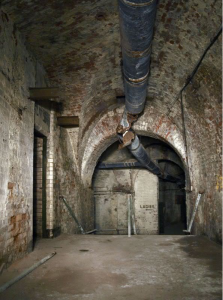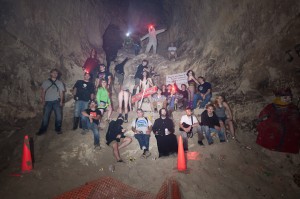We use cities every day: their streets, benches, parks, buildings. But we never really know what’s
behind their façades. The stories, told by derelict or abandoned buildings, distant places or the
network of underground sewers and canals are documented by urban explorers. They dive into the past, all
with their own motivations and expectations. What is this act of urban exploration (often shortened as
urbex or UE) and how is it being used?
For the fieldwork that we had to conduct during our time at the Manchester
Metropolitan University, our group opted to research the increasingly popular act of urban exploration.
The initial idea, to participate in urban exploration and to combine this with the reflection on the use
of industrial heritage in Manchester proved to be too difficult to be carried out in the short timeframe
we had, according to the people that were contacted. The main reason is that it’s hard to contact the
explorers and they don’t easily accept academics in their closed community. Secondly, the question on
how the industrial heritage in Manchester is used by the municipality is fairly easy to solve. A number
of old industrial sites basically still exist because there isn’t enough funding to demolish the
buildings or to regenerate them. Thus, we adapted the original idea to a desktop research, fueled with
an interview and several virtual contacts.
Our research consisted mainly of desktop research because of the difficulties we encountered in getting in contact with urban explorers, as was previously stated. We did have one interview with Tim Edensor, lecturer in Human Geography at Manchester Metropolitan University and have sent several emails to other academics with an interest in urban exploration. These are Martin Dodge, Senior Lecturer in Human Geography at the University of Manchester; Mark Banks of Open University; Paul Dobraszczyk, lecturer at University of Manchester; and Bradley L. Garrett, PhD student at University of London. To get a more detailed view of the field and the act of urban exploration itself, we got in touch with an anonymous participant of urban exploration and with student and urbex-member Leigh Jones. Both of them have given us information on literature and contacts in the field.
The next step of our research was mostly focused on research sources. The lack of literature about urban exploration and the importance of the internet as a means of communication for urban exploration pointed us in that direction. We found that there are hundreds of websites dedicated to urban exploration. Some are fairly general; others focus on a certain type of building/infrastructure or on certain places. Some of these websites show predominantly pictures, others use urban exploration as a way to find out more about the history of the buildings/infrastructure (e.g. sub-urban.com) or give an introduction on urban exploration. Many of these websites are forums and are used as a place to exchange ideas and experiences. The most active and qualitative forum for the United Kingdom is 28dayslater.co.uk.
Based on the internet research we managed to get an insight of the urban exploration scene in
Manchester. It seems to be quite active and especially interested in underground explorations and in
climbing on rooftops and cranes. The most popular location is without a doubt the Victorian Arches in
the surrounding of the Cathedral of Manchester. These arches were built in 1838 and functioned as work
places for merchants. During the Second World War, they were used as shelters. No they are frequently
being visited by urban explorers and one of them calls it the best urbex site of Manchester. Only in
2012, 10 reports about the Victorian Arches have been posted on the forum 28dayslater. Keeping in mind
that certainly not every urban explorer also posts reports on this forum, there is no doubt that this
location is very popular among urban explorers.

Pictures of urban exploration tours in Manchester often show quite big groups. It seems thus that the
Manchester urban exploration scene is not only a virtual community, but that they also meet each other
on the field. Furthermore, they seem not to care too much about anonymity, since they are recognizable
on most of the pictures. This is contradictory to the majority of urban explorers, although they all
have a nickname.

To visualize the urban exploration possibilities in Manchester, we have created an alternative map for Manchester. By doing this we want to provoke different questions: Is urban exploration still a subculture or did it become part of the mainstream? Is it merely a hunch for a different kind of aesthetics or do urban explorers really provoke the ideas of the commodification of our societies in general? Do only “real” urban explorers have the right to explore these spaces? What creates the image of a city? The monuments and shops or the derelict buildings that tell a different story?
Based on the forums 28dayslater and NorthWest Exploration Forum and some photo blogs, we selected different locations in Manchester and linked them to the pictures. To our surprise, these locations were not mainly situated on the borders of the city, but in the very centre of Manchester. This has partly to do with the popularity of underground and rooftop exploration in Manchester. Derelict (industrial) buildings are often to be found on the fringes of cities, while sewers and tunnels run throughout the whole city, and the same is of course true for rooftops.
Urban exploration Manchester weergeven op een grotere kaart
This map brings some interesting questions to the fore. First of all, the invisible is made visible. This map can encourage people to look differently at a city and to think about what would be behind facades. Secondly, it shows that the inner city is more than just monuments and shops. It seems to counter the commodification of city centers. It is also about a different use of the city, not as a place of consumption, but as a place of discovery, excitement and exploration. On the other hand, one can also wonder if urban explorers really provoke the ideas of the commodification of our societies in general or if urban exploration is just a hobby, although a special one. Probably the second will most often be the right motivation, but this does not mean that urban exploration cannot raise awareness about the commodified city.
Although, in the end we weren’t able to ‘experience’ urban exploration ourselves, we feel like we’ve got a pretty good insight to the nature of this phenomenon. The task proved to be more difficult than we had foreseen but through our account of urban exploring in Manchester we hope to have contributed a meaningful insight to the act of urbex and its community.
Laura May and Tine Marguillier
